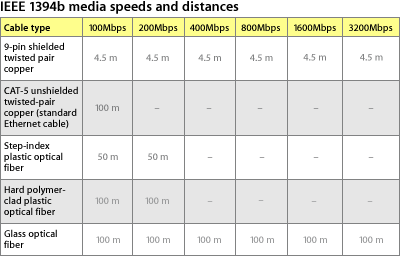Xpert1394 Series
![]()
![]()
Xpert1394 Series
| 1394 (also known as FireWire and iLink is a
high-speed serial bus providing the bandwidth and flexibility required for high-speed PC
I/O and multimedia applications-like entertainment, gaming, video editing, high-end audio,
and a host of other needs. It is the enabler that will revolutionize home entertainment,
gaming, and Internet access by providing a high-speed digital link, between personal
computers (PCs), peripherals, camcorders, VCRs, printers, TVs, and digital cameras. Performance Flexibilty IEEE 1394, FireWire, iLink, these are some of the latest buzzwords in the computing industry. They refer to the IEEE specification for a high speed, flexible, easy to use, serial connectivity standard. However, within the multi-media environment, there are a baffling number of interfaces to choose from. A quick overview of the main contenders is given below and a comparison table.
How the standards
compare? Centronics 1284 - When IBM introduced the PC, the Centronics 1284 port was included to provide an alternative to the RS232 port. This interface was primarily aimed at dot matrix printers. As it is a parallel interface, transmitting 8 bits at a time, this protocol was originally seen as a high performance interface. As a result, different modes were developed within the specification to address faster and faster peripherals. There are 2 faster modes. The first is Enhanced Capability Port mode (ECP), which is a bi-directional mode for use with printers and scanners. The mode operates at transfer rates of between 2 and 4M bytes per second. The second is Enhanced Parallel Port mode (EPP). This mode operates at between 500k Bytes and 2M Bytes per second, depending on the speed of the slowest interface. This mode is suitable for network adapters and portable hard drives. The main problem with the parallel interface is that the connector tends to be bulky. USB - The Universal Serial Bus was designed as a plug and play interface for PC peripherals. The advantage of USB is that devices can be added to the PC in a daisy chain fashion, without turning the computer off. This standard was developed by COMPAQ, IBM, DEC, Intel, Microsoft, NEC and Northern Telecom. The original USB standard supports a speed of 12M bits per second. This interface has become so widely used that Microsoft have incorporated it into Windows 98, and most computers come equipped with USB ports. Many peripheral products are now available. SCSI - The Small Computer Serial Interface is a parallel interface designed to connect computers and fast peripherals such as hard drives and CD-ROM drives. The standard was developed by Apple. SCSI has evolved over the years from SCSI-1, which supported a maximum data rate of 5M Bytes per second to the latest standard Ultra-3 SCSI, which supports data rates of 160 M Bytes per second and up to 16 devices in a daisy chain fashion. This daisy chain ability allows one card to support all of the external peripherals, reducing the cost to the user. USB2 - The standard for the Universal Serial Bus 2 has been released recently. The final specification was announced at WinHEC in April 2000. This specification increases the full-speed transfer rate from 12M bits per second in USB1.1 to 480 M bits per second. USB and USB2 are attractive to the user, as all the peripherals connect using the same connector; a simple push in plug akin to those used on games machines. Currently, there are few components available that support this standard, but several manufacturers are developing products. This interface is not shipped with any computers yet (July 2000). IEEE 1394/FireWire/iLINK - This standard is currently available and provides a 400M bit per second serial link. It can support up to 63 different nodes on a single daisy chain. It also provides plug and play capability. One of the major advantages of 1394 is its ability to provide peer-to-peer connectivity. This enables peripherals to talk directly to each other without using a host computer processor. In fact, a host computer is not required at all, unlike the situation with USB. FireWire provides 2 types of data transfer, asynchronous and isochronous. Asynchronous data transfer is used in traditional load and store applications. Isochronous data transfer is aimed at multimedia applications, where data has to arrive at a set time. Implementing isochronous data transfer reduces the need for buffering within the playback media, reducing cost while ensuring continuous playback for the viewer or listener. Discussions are underway to increase the speed of 1394 to between 800 and 1600M bits per second by the end of 2000. Long haul systems are also being developed. Summary With the market embracing this new technology, design engineers in many fields will begin to use this interface. They will need to use products from manufacturers familiar with the technology, and who are developing new products. This approach will ensure that they do not get left behind as 1394 speeds increase and consumers expect more 1394 enabled products. |
| FireWire
Duplicator: For
FireWire stand-alone duplication: Daisy Chain two U2FWEIDE525-2 through
FireWire port. Supports DVD-R/RW, DVD+R/RW, CD-R/RW. |
 |
|
|
|
| About 1394 & DV FAQ | General 1394 FAQ |